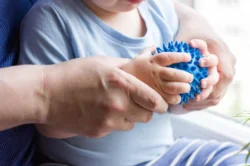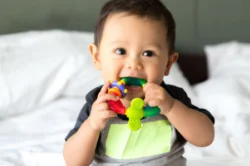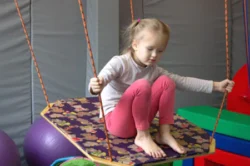Autism and Sensory Disorders: Therapeutic Impact of Sensory Toys
July 9, 2024
Autism and Sensory Disorders: Therapeutic Impact of Sensory Toys








Separation anxiety can feel overwhelming—for both children and parents. For families of children with special needs, the challenges can become
Sensory Integration Therapy (SIT) has emerged as a powerful tool for children and adults facing sensory processing difficulties. Often seen
Sensory diets can be powerful tools for supporting children with Sensory Processing Disorder (SPD). But what exactly is a sensory
Why does my child cover their ears at birthday parties? Why do the seams on socks cause meltdowns, or loud
How are anxiety and sensory processing challenges related, especially in children? Many parents and professionals notice that children with Sensory
Raising a child with dyslexia can feel overwhelming at times, but it’s important to remember that you are not alone.
Independence is an essential milestone in the development of any child, and for children with special needs, it holds even
Attention-Deficit/Hyperactivity Disorder (ADHD) is a common neurodevelopmental condition that often manifests in early childhood. For parents, recognizing the signs of
Occupational therapy (OT) plays a vital role in supporting children with autism as they develop the skills needed to engage
Sensory play is much more than just fun—it’s a powerful tool for fostering your child’s development across multiple domains. From
Sensory play is an unparalleled tool in fostering childhood development. By engaging the senses—be it touch, sight, hearing, smell, taste,
Sensory Processing Disorder (SPD) affects how individuals interpret and respond to sensory input from the environment. For those who experience
Separation anxiety can feel overwhelming—for both children and parents. For families of children with special needs, the challenges can become
Supporting kids with ADHD takes more than reminders and patience. For parents and educators, understanding ADHD and providing the right
Attention Deficit Hyperactivity Disorder (ADHD) and Sensory Processing Disorder (SPD) are two conditions frequently discussed in pediatric development and mental
Sensory overload occurs when one or more of the body's senses become overstimulated by external stimuli. For individuals affected, this
Raising a child with ADHD (Attention-Deficit/Hyperactivity Disorder) presents unique challenges, requiring patience, understanding, and adaptability. However, with the right strategies
Sensory diets are systematic and individualized strategies that help modify or meet sensory needs, particularly benefiting children and adults with
Parents, educators, and therapists often face a perplexing challenge when trying to distinguish between Sensory Processing Disorder (SPD) and Attention
25 Sensory Activities and Exercises for Kids with Sensory Processing Disorder and ADHD If your child has Sensory Processing Disorder
Children with Attention-deficit/hyperactivity disorder (ADHD) and Autism Spectrum Disorders (ASD) face difficulties in regulating their emotions and sensory input from
How Sensory Toys Help with ADHD: A Detailed Guide If you are a parent of a child with ADHD or
Managing Toddler ADHD Symptoms: A Parent’s Guide ADHD (Attention Deficit Hyperactivity Disorder) in toddlers can present a unique set of
Uniting Communities: Online Support and Resources for Autism, SPD, and ADHD Navigating neurodiversity can be a complex and sometimes isolating
Separation anxiety can feel overwhelming—for both children and parents. For families of children with special needs, the challenges can become
Separation anxiety can be tough on any child, but for children with special needs, it often goes hand in hand
Sensory processing disorder (SPD) often flies under the radar, yet it plays a crucial role in understanding the complexities of
Sensory overload occurs when one or more of the body's senses become overstimulated by external stimuli. For individuals affected, this
Sensory diets are systematic and individualized strategies that help modify or meet sensory needs, particularly benefiting children and adults with
“It takes a village to raise a child. It takes a child with autism to raise the consciousness of the
Dealing with autism meltdowns can be a challenging experience for caregivers, teachers, and those on the spectrum alike. A meltdown
Understanding Autism Regression in Children What is Autism Regression? Autism spectrum disorder (ASD) is marked by a range of symptoms
How Sensory Toys Facilitate Learning for Children with Autism Autism Spectrum Disorder (ASD) affects approximately 1 in 54 children in
Uniting Communities: Online Support and Resources for Autism, SPD, and ADHD Navigating neurodiversity can be a complex and sometimes isolating
Have you or a loved one received a diagnosis and now are having a long wait time to find answers
Boosting Cognitive Development in Autism: The Role of Sensory Toys Autism Spectrum Disorder (ASD) affects approximately 1 in 54 children
Separation anxiety can feel overwhelming—for both children and parents. For families of children with special needs, the challenges can become
Separation anxiety can be tough on any child, but for children with special needs, it often goes hand in hand
Picture this scene: You’ve finally gotten your baby into a comfortable sleep routine. Nights are restful, naps are scheduled, and
Sleep regressions can feel like an uphill battle for parents. One moment your baby is sleeping soundly, and the next,
Sleep regressions are a temporary yet challenging phase many parents encounter as their babies and toddlers grow. Understanding the approximate
Sleep regressions. The phrase alone can strike fear into the hearts of even the most seasoned parents. If your baby
Sleep regressions can feel like a relentless obstacle to parents striving for a peaceful night's rest. But you're not alone,
Supporting kids with ADHD takes more than reminders and patience. For parents and educators, understanding ADHD and providing the right
Sensory Integration Therapy (SIT) has emerged as a powerful tool for children and adults facing sensory processing difficulties. Often seen
Sensory diets can be powerful tools for supporting children with Sensory Processing Disorder (SPD). But what exactly is a sensory
Why does my child cover their ears at birthday parties? Why do the seams on socks cause meltdowns, or loud
How are anxiety and sensory processing challenges related, especially in children? Many parents and professionals notice that children with Sensory
Separation anxiety can feel overwhelming—for both children and parents. For families of children with special needs, the challenges can become
Picture this scene: You’ve finally gotten your baby into a comfortable sleep routine. Nights are restful, naps are scheduled, and
Sleep regressions can feel like an uphill battle for parents. One moment your baby is sleeping soundly, and the next,
Sleep regressions are a temporary yet challenging phase many parents encounter as their babies and toddlers grow. Understanding the approximate
Sleep regressions. The phrase alone can strike fear into the hearts of even the most seasoned parents. If your baby
Sleep regressions can feel like a relentless obstacle to parents striving for a peaceful night's rest. But you're not alone,
Supporting kids with ADHD takes more than reminders and patience. For parents and educators, understanding ADHD and providing the right
Sensory Integration Therapy (SIT) has emerged as a powerful tool for children and adults facing sensory processing difficulties. Often seen
Sensory diets can be powerful tools for supporting children with Sensory Processing Disorder (SPD). But what exactly is a sensory
Why does my child cover their ears at birthday parties? Why do the seams on socks cause meltdowns, or loud
How are anxiety and sensory processing challenges related, especially in children? Many parents and professionals notice that children with Sensory
When your child struggles with writing, it's easy to assume they just need practice or a little more time to
Picture this scene: You’ve finally gotten your baby into a comfortable sleep routine. Nights are restful, naps are scheduled, and
Sleep regressions can feel like an uphill battle for parents. One moment your baby is sleeping soundly, and the next,
Sleep regressions are a temporary yet challenging phase many parents encounter as their babies and toddlers grow. Understanding the approximate
Sleep regressions. The phrase alone can strike fear into the hearts of even the most seasoned parents. If your baby
Sleep regressions can feel like a relentless obstacle to parents striving for a peaceful night's rest. But you're not alone,
Supporting kids with ADHD takes more than reminders and patience. For parents and educators, understanding ADHD and providing the right
Sensory Integration Therapy (SIT) has emerged as a powerful tool for children and adults facing sensory processing difficulties. Often seen
Sensory diets can be powerful tools for supporting children with Sensory Processing Disorder (SPD). But what exactly is a sensory
Why does my child cover their ears at birthday parties? Why do the seams on socks cause meltdowns, or loud
How are anxiety and sensory processing challenges related, especially in children? Many parents and professionals notice that children with Sensory
Physical therapy plays an essential role in helping children achieve the developmental milestones necessary for functional independence, confidence, and overall
Anxiety is a natural emotion, but when it begins to interfere with a child’s everyday activities, it becomes a cause
Because staying in the loop is important
Author: DrSensory
July 9, 2024
As a parent or caregiver of a child with Autism Spectrum Disorder (ASD) or Attention Deficit Hyperactivity Disorder (ADHD), managing your child’s sensory needs can be challenging. Sensory toys can play a critical part in helping all children, especially those with diagnosed disorders, to regulate their senses and provide a comfortable and calming environment specific to their needs.
Most individuals with ASD have sensory processing difficulties and therefore struggle to process stimuli leading to either overstimulation or understimulation of their senses. One solution to address this is providing sensory toys that offer soothing and calming effects.

Sensory balls are an excellent way to provide tactile stimulation. The squishy texture can help an individual with ASD to focus, improve hand-eye coordination, and develop fine motor skills. Alternatively, using fidget toys, such as sensory putty or squishy stress balls, can provide the same benefits and maintain focus during lessons or activities.

Another type of sensory toy is kinetic sand. This provides a unique and therapeutic experience to children with sensory needs. It provides endless possibilities for shaping and molding while keeping the mind calm and focused. Studies have found that Kinetic sand can improve a child’s sensory stimulation, fine motor skills, and creativity.

Weighted blankets provide the deep pressure sensation that the user finds soothing and calming. Weighted blankets can aid in reducing anxiety and enhancing relaxation. They are a great option for children with ADHD to improve focus and concentration level during tasks. The blankets come in various sizes, shapes, and fabrics to offer maximum comfort to suit the individual’s preference.

Another alternative is Therapy bands that apply pressure on different body parts, such as the arms, back, and legs. The bands provide the user with a feeling of stability and help in regulating sensory challenges. Therapy bands work well for children who struggle with self-regulation and have difficulty remaining still and focused.

Chewing toys are beneficial in addressing oral sensory preferences. Chewable toys provide the opportunity for children to satisfy their oral sensory needs, something that begins in infancy and promotes exploration of an environment. Research has found that chewing can modulate stress, improve attention span, and enhance learning.
Additionally, aromatherapy oils are a great way to stimulate the senses. The use of essential oils, such as lavender, jasmine, or vanilla, can calm and relax the body and mind. Aromatherapy has been proven to soothe irritability, reduce hyperactivity, and increase focus in individuals with sensory issues.

Another excellent sensory tool is the Tangle toy that offers a creative and calming outlet for motor needs. The Tangle toy can provide a variety of therapeutic benefits, such as reducing stress and improving fine motor coordination. It has been reported that the tangle toy can improve attention span and promote positive behavior.

Sensory swings offer a safe space for children with sensory needs. Swinging provides therapeutic benefits, including vestibular stimulation and deep pressure sensation. Sensory swings offer a calming and relaxing environment, reducing anxiety and stress levels.
Mini water fountains can provide a calming sensory experience, specifically for those who find the sound of flowing water relaxing. The calming sound of a mini waterfall can soothe the senses and aid in focus.

Another popular sensory toy is the sensory table, which provides a hands-on sensory experience for children. A sensory table is typically filled with materials such as sand, water, or rice, providing a tactile experience that can be calming and soothing. Research has shown that tactile stimulation can have a positive effect on children with ADHD and Autism Spectrum Disorders by reducing stress and anxiety.
Separation anxiety can feel overwhelming—for both children and parents. For families of children with special needs, the challenges can become
Separation anxiety can be tough on any child, but for children with special needs, it often goes hand in hand
Picture this scene: You’ve finally gotten your baby into a comfortable sleep routine. Nights are restful, naps are scheduled, and
Sleep regressions can feel like an uphill battle for parents. One moment your baby is sleeping soundly, and the next,
Sleep regressions are a temporary yet challenging phase many parents encounter as their babies and toddlers grow. Understanding the approximate
Separation anxiety can feel overwhelming—for both children and parents. For families of children with special needs, the challenges can become
Sensory Integration Therapy (SIT) has emerged as a powerful tool for children and adults facing sensory processing difficulties. Often seen
Sensory diets can be powerful tools for supporting children with Sensory Processing Disorder (SPD). But what exactly is a sensory
Why does my child cover their ears at birthday parties? Why do the seams on socks cause meltdowns, or loud
How are anxiety and sensory processing challenges related, especially in children? Many parents and professionals notice that children with Sensory
Attention-Deficit/Hyperactivity Disorder (ADHD) is a common neurodevelopmental condition that often manifests in early childhood. For parents, recognizing the signs of
Sensory play is much more than just fun—it’s a powerful tool for fostering your child’s development across multiple domains. From
Sensory play is an unparalleled tool in fostering childhood development. By engaging the senses—be it touch, sight, hearing, smell, taste,
The neurological and psychological study of autism spectrum conditions has evolved significantly over the decades, and with it, so have
Sensory Processing Disorder (SPD) affects the way children interpret and respond to sensory information from the world around them. Unlike
When most people think about the senses, the traditional five often come to mind: sight, sound, taste, touch, and smell.
Sensory processing disorder (SPD) often flies under the radar, yet it plays a crucial role in understanding the complexities of
Separation anxiety can feel overwhelming—for both children and parents. For families of children with special needs, the challenges can become
Supporting kids with ADHD takes more than reminders and patience. For parents and educators, understanding ADHD and providing the right
Attention Deficit Hyperactivity Disorder (ADHD) and Sensory Processing Disorder (SPD) are two conditions frequently discussed in pediatric development and mental
Sensory overload occurs when one or more of the body's senses become overstimulated by external stimuli. For individuals affected, this
Raising a child with ADHD (Attention-Deficit/Hyperactivity Disorder) presents unique challenges, requiring patience, understanding, and adaptability. However, with the right strategies
Sensory diets are systematic and individualized strategies that help modify or meet sensory needs, particularly benefiting children and adults with
25 Sensory Activities and Exercises for Kids with Sensory Processing Disorder and ADHD If your child has Sensory Processing Disorder
How Sensory Toys Help with ADHD: A Detailed Guide If you are a parent of a child with ADHD or
Managing Toddler ADHD Symptoms: A Parent’s Guide ADHD (Attention Deficit Hyperactivity Disorder) in toddlers can present a unique set of
Uniting Communities: Online Support and Resources for Autism, SPD, and ADHD Navigating neurodiversity can be a complex and sometimes isolating
Have you or a loved one received a diagnosis and now are having a long wait time to find answers
Overcoming Behavioral Challenges in ADHD with Sensory Toys ADHD and Autism Spectrum Disorders can present challenges for children, including difficulties
Separation anxiety can feel overwhelming—for both children and parents. For families of children with special needs, the challenges can become
Separation anxiety can be tough on any child, but for children with special needs, it often goes hand in hand
Sensory processing disorder (SPD) often flies under the radar, yet it plays a crucial role in understanding the complexities of
Sensory overload occurs when one or more of the body's senses become overstimulated by external stimuli. For individuals affected, this
Sensory diets are systematic and individualized strategies that help modify or meet sensory needs, particularly benefiting children and adults with
“It takes a village to raise a child. It takes a child with autism to raise the consciousness of the
Dealing with autism meltdowns can be a challenging experience for caregivers, teachers, and those on the spectrum alike. A meltdown
Understanding Autism Regression in Children What is Autism Regression? Autism spectrum disorder (ASD) is marked by a range of symptoms
How Sensory Toys Facilitate Learning for Children with Autism Autism Spectrum Disorder (ASD) affects approximately 1 in 54 children in
Uniting Communities: Online Support and Resources for Autism, SPD, and ADHD Navigating neurodiversity can be a complex and sometimes isolating
Have you or a loved one received a diagnosis and now are having a long wait time to find answers
Boosting Cognitive Development in Autism: The Role of Sensory Toys Autism Spectrum Disorder (ASD) affects approximately 1 in 54 children
Separation anxiety can feel overwhelming—for both children and parents. For families of children with special needs, the challenges can become
Separation anxiety can be tough on any child, but for children with special needs, it often goes hand in hand
Picture this scene: You’ve finally gotten your baby into a comfortable sleep routine. Nights are restful, naps are scheduled, and
Sleep regressions can feel like an uphill battle for parents. One moment your baby is sleeping soundly, and the next,
Sleep regressions are a temporary yet challenging phase many parents encounter as their babies and toddlers grow. Understanding the approximate
Sleep regressions. The phrase alone can strike fear into the hearts of even the most seasoned parents. If your baby
Sleep regressions can feel like a relentless obstacle to parents striving for a peaceful night's rest. But you're not alone,
Supporting kids with ADHD takes more than reminders and patience. For parents and educators, understanding ADHD and providing the right
Sensory Integration Therapy (SIT) has emerged as a powerful tool for children and adults facing sensory processing difficulties. Often seen
Sensory diets can be powerful tools for supporting children with Sensory Processing Disorder (SPD). But what exactly is a sensory
Why does my child cover their ears at birthday parties? Why do the seams on socks cause meltdowns, or loud
How are anxiety and sensory processing challenges related, especially in children? Many parents and professionals notice that children with Sensory
Separation anxiety can feel overwhelming—for both children and parents. For families of children with special needs, the challenges can become
Picture this scene: You’ve finally gotten your baby into a comfortable sleep routine. Nights are restful, naps are scheduled, and
Sleep regressions can feel like an uphill battle for parents. One moment your baby is sleeping soundly, and the next,
Sleep regressions are a temporary yet challenging phase many parents encounter as their babies and toddlers grow. Understanding the approximate
Sleep regressions. The phrase alone can strike fear into the hearts of even the most seasoned parents. If your baby
Sleep regressions can feel like a relentless obstacle to parents striving for a peaceful night's rest. But you're not alone,
Supporting kids with ADHD takes more than reminders and patience. For parents and educators, understanding ADHD and providing the right
Sensory Integration Therapy (SIT) has emerged as a powerful tool for children and adults facing sensory processing difficulties. Often seen
Sensory diets can be powerful tools for supporting children with Sensory Processing Disorder (SPD). But what exactly is a sensory
Why does my child cover their ears at birthday parties? Why do the seams on socks cause meltdowns, or loud
How are anxiety and sensory processing challenges related, especially in children? Many parents and professionals notice that children with Sensory
Anxiety is a natural emotion, but when it begins to interfere with a child’s everyday activities, it becomes a cause
Picture this scene: You’ve finally gotten your baby into a comfortable sleep routine. Nights are restful, naps are scheduled, and
Sleep regressions can feel like an uphill battle for parents. One moment your baby is sleeping soundly, and the next,
Sleep regressions are a temporary yet challenging phase many parents encounter as their babies and toddlers grow. Understanding the approximate
Sleep regressions. The phrase alone can strike fear into the hearts of even the most seasoned parents. If your baby
Sleep regressions can feel like a relentless obstacle to parents striving for a peaceful night's rest. But you're not alone,
Supporting kids with ADHD takes more than reminders and patience. For parents and educators, understanding ADHD and providing the right
Sensory Integration Therapy (SIT) has emerged as a powerful tool for children and adults facing sensory processing difficulties. Often seen
Sensory diets can be powerful tools for supporting children with Sensory Processing Disorder (SPD). But what exactly is a sensory
Why does my child cover their ears at birthday parties? Why do the seams on socks cause meltdowns, or loud
How are anxiety and sensory processing challenges related, especially in children? Many parents and professionals notice that children with Sensory
Anxiety is a natural emotion, but when it begins to interfere with a child’s everyday activities, it becomes a cause
Attention-Deficit/Hyperactivity Disorder (ADHD) is a common neurodevelopmental condition that often manifests in early childhood. For parents, recognizing the signs of
Because staying in the loop is important
Fill out the form below, and we’ll be in touch shortly.
Join thousands of parents and educators each week


